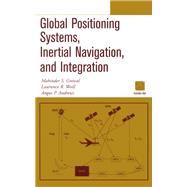Global Positioning Systems, Inertial Navigation, and Integration
, by Mohinder S. Grewal (College of Engineering and Computer Science, California State Univ. at Fullerton); Lawrence R. Weill (College of Mathematics and Natural Sciences, California State Univ. at Fullerton); Angus P. Andrews (Rockwell Science Center, Th- ISBN: 9780471200710 | 0471200719
- Cover:
- Copyright: 9/1/2001
Written by recognized authorities in the field, this book provides engineers, computer scientists, and others with a working familiarity with the theory and contemporary applications of Global Positioning Systems (GPS), Inertial Navigational Systems, and Kalman filters. Throughout, the focus is on solving real-world problems, with an emphasis on the effective use of state-of-the-art integration techniques for those systems, especially the application of Kalman filtering. To that end, the authors explore the various subtleties, common failures, and inherent limitations of the theory as it applies to real-world situations, and provide numerous detailed application examples and practice problems, including GPS-aided INS, modeling of gyros and accelerometers, and WAAS and LAAS.
Drawing upon their many years of experience with GPS, INS, and the Kalman filter, the authors present numerous design and implementation techniques not found in other professional references, including original techniques for: *Representing the problem in a mathematical model *Analyzing the performance of the GPS sensor as a function of model parameters *Implementing the mechanization equations in numerically stable algorithms *Assessing computation requirements *Testing the validity of results *Monitoring GPS, INS, and Kalman filter performance in operation
In order to enhance comprehension of the subjects covered, the authors have included software in MATLAB, demonstrating the workings of the GPS, INS, and filter algorithms. In addition to showing the Kalman filter in action, the software also demonstrates various practical aspects of finite word length arithmetic and the need for alternative algorithms to preserve result accuracy.






